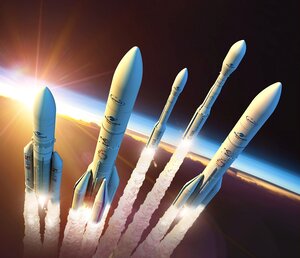Accept all cookies Accept only essential cookies See our Cookie Notice

About ESA
The European Space Agency (ESA) is Europe’s gateway to space. Its mission is to shape the development of Europe’s space capability and ensure that investment in space continues to deliver benefits to the citizens of Europe and the world.
Highlights
ESA - United space in Europe
This is ESA ESA facts Member States & Cooperating States Funding Director General Top management For Member State Delegations European vision European Space Policy ESA & EU Space Councils Responsibility & Sustainability Annual Report Calendar of meetings Corporate newsEstablishments & sites
ESA Headquarters ESA ESTEC ESA ESOC ESA ESRIN ESA EAC ESA ESAC Europe's Spaceport ESA ESEC ESA ECSAT Brussels Office Washington OfficeWorking with ESA
Business with ESA ESA Commercialisation Gateway Law at ESA Careers Cyber resilience at ESA IT at ESA Newsroom Partnerships Merchandising Licence Education Open Space Innovation Platform Integrity and Reporting Administrative Tribunal Health and SafetyMore about ESA
History ESA Historical Archives Exhibitions Publications Art & Culture ESA Merchandise Kids Diversity ESA Brand Centre ESA ChampionsLatest
Space in Member States
Find out more about space activities in our 23 Member States, and understand how ESA works together with their national agencies, institutions and organisations.
Science & Exploration
Exploring our Solar System and unlocking the secrets of the Universe
Go to topicAstronauts
Missions
Juice Euclid Webb Solar Orbiter BepiColombo Gaia ExoMars Cheops Exoplanet missions More missionsActivities
International Space Station Orion service module Gateway Concordia Caves & Pangaea BenefitsLatest
Space Safety
Protecting life and infrastructure on Earth and in orbit
Go to topicAsteroids
Asteroids and Planetary Defence Asteroid danger explained Flyeye telescope: asteroid detection Hera mission: asteroid deflection Near-Earth Object Coordination CentreSpace junk
About space debris Space debris by the numbers Space Environment Report In space refuelling, refurbishing and removingSafety from space
Clean Space ecodesign Zero Debris Technologies Space for Earth Supporting Sustainable DevelopmentApplications
Using space to benefit citizens and meet future challenges on Earth
Go to topicObserving the Earth
Observing the Earth Future EO Copernicus Meteorology Space for our climate Satellite missionsCommercialisation
ESA Commercialisation Gateway Open Space Innovation Platform Business Incubation ESA Space SolutionsEnabling & Support
Making space accessible and developing the technologies for the future
Go to topicBuilding missions
Space Engineering and Technology Test centre Laboratories Concurrent Design Facility Preparing for the future Shaping the Future Discovery and Preparation Advanced Concepts TeamSpace transportation
Space Transportation Ariane Vega Space Rider Future space transportation Boost! Europe's Spaceport Launches from Europe's Spaceport from 2012Latest

Ariane 4 and Ariane 5 launchers artist view
Thank you for liking
You have already liked this page, you can only like it once!
Ariane 4 is justly known as the ‘workhorse’ of the Ariane family. Since its first flight on 15 June 1988 it has made over 100 successful launches. The Ariane 4 has proved ideal for launching satellites for communications and Earth observation, as well as for scientific research.
This launcher is extremely versatile. The first stage can hold two or four strap-on boosters, or none at all. This means that it can lift into orbit satellites weighing from 2000 to nearly 4800 kg in GTO, nearly three times as much as the Ariane-3 launcher. Now its role is gradually being taken over by the Ariane-5 launcher and the last Ariane-4 flight is expected to take place in 2003.
Ariane 4 has captured 50% of the market in launching commercial satellites showing that Europe can more than hold its own in the commercial launch market.
Ariane 5 is designed to meet the challenges of the new millennium. It meets several requirements: the ability to launch larger satellites, the increasing use of low orbits for servicing the International Space Station and the need to reduce costs while maintaining a high reliability.
Its first successful launch took place on 30 October 1997 while its first operational flight occurred in December 1999, when it launched ESA’s X-ray Multi-Mirror (XMM). Ariane 5 has proved highly reliable and economic, and has been used to launch satellites for communications, Earth observation and scientific research into geostationary orbits and Sun-synchronous orbits. ESA had to build a new launch site at Europe’s spaceport in Kourou for this new member of the Ariane family as well as facilities to make the solid boosters needed to launch this, the most powerful launcher in the Ariane family. Ariane 5 can be used for launches into geostationary orbit, medium-Earth orbit and low-Earth orbit, as well as for launches to other planets.
-
CREDIT
ESA-D. Ducros -
LICENCE
ESA Standard Licence

The Ariane launcher family artist's view

Artist's view of Europe's launcher family

Artist's view of Europe's launcher family

Artist's view of Europe's launcher family















 Germany
Germany
 Austria
Austria
 Belgium
Belgium
 Denmark
Denmark
 Spain
Spain
 Estonia
Estonia
 Finland
Finland
 France
France
 Greece
Greece
 Hungary
Hungary
 Ireland
Ireland
 Italy
Italy
 Luxembourg
Luxembourg
 Norway
Norway
 The Netherlands
The Netherlands
 Poland
Poland
 Portugal
Portugal
 Czechia
Czechia
 Romania
Romania
 United Kingdom
United Kingdom
 Slovenia
Slovenia
 Sweden
Sweden
 Switzerland
Switzerland

























